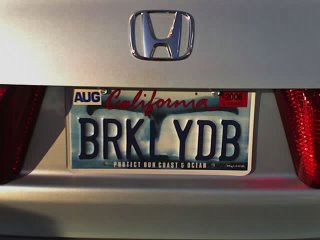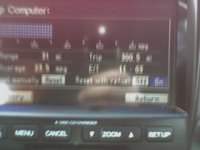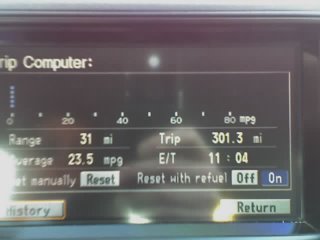Honda Accord Hybrid review.
Like everyone else in California, I bought myself a hybrid car recently. I have a 2005 Honda Accord Hybrid. This is a larger and more powerful sedan than the Toyota Prius or the Honda Insight. I test-drove those, but I didn't like them very much. They were small, underpowered and felt fragile on the road. The Accord, by contrast, feels solid, handles well, and accelerates respectably when you ask it to.
 Of course, I needed some high-tech California personalized plates to go with the car. Fortunately, this one was available. Note the deft combination of my interests in scuba diving and high-performance embeddable database technology.
Of course, I needed some high-tech California personalized plates to go with the car. Fortunately, this one was available. Note the deft combination of my interests in scuba diving and high-performance embeddable database technology.
I used to drive a Subaru Legacy Outback wagon with all-wheel drive. That was our mountain car, and I had bike racks and ski racks mounted interchangeably on the roof. A couple of months earlier, my wife traded in her Toyota Avalon for a Toyota Highlander hybrid with four-wheel drive. That meant that we had two mountain cars. When my Subaru got needy, I decided to trade down to a sensible city car.
I bought the Honda with confused motives. I wanted a car that I enjoyed driving, and I was sure that I would have gone nuts in a Prius or an Insight. At the same time, I wanted to get hybrid mileage. This was about the time that gas spiked above three dollars a gallon, and I wanted to burn less oil.
The Accord's EPA mileage estimate is 37mpg highway and 27 mpg city, but in practice, it does considerably worse. My commute to work is short -- just four miles (I can't bike, alas), so in my first month or so of driving it, I was averaging about 19.5 mpg. For contrast, I used to get 22 mpg in my Subaru! My wife gets around 28mpg in city driving in her Highlander.
Too late, I did a bunch of research on hybrids and gas mileage. Here are the bullet points:
- The EPA mileage estimates you see are almost always way higher than the mileage you'll actually get.
- Short commutes like mine are the worst on hybrid fuel efficiency.
- In order to improve your mileage, you may need to change the way that you drive.
The first bullet bugs me tremendously. If you're from the EPA and you read this post, please fix your mileage estimates. On top of that, there just wasn't much I could do about either of the first two issues. The third, at least, held out some hope for improvement.
The Accord, like other hybrid cars, has a display screen that will tell you what the car is doing while you are driving it. You can use that screen, along with some other dashboard indicators, to understand what kind of mileage you are getting instantaneously, and what your average mileage is.
 The Toyota has the same kind of display. (Sooner or later, somene is going to get into an accident caused by staring at the dashboard rather than watching the road.) If you were foolhardy enough to use your mobile phone to take a picture of the Accord's "trip info" display while you were driving, it would look like this.
The Toyota has the same kind of display. (Sooner or later, somene is going to get into an accident caused by staring at the dashboard rather than watching the road.) If you were foolhardy enough to use your mobile phone to take a picture of the Accord's "trip info" display while you were driving, it would look like this.
Pretty fuzzy, pretty hard to read, because it's hard to hold a cell phone steady in a moving car. That blue bar coming in at the top left of the image tells you that the car is getting thirty miles per gallon just at that instant. That's a reasonable number for tooling down a city street. Because of all the stops and starts you do in city driving, it's hard to do much better than thirty or forty miles per gallon in any sustained way on this display. You can do much better on the freeway.
 Just a short while after taking that photograph, I pulled into a gas station to refuel, and took this clearer picture of the display. In this shot, you can see that I am stopped (the blue bar says zero mpg), that I have averaged 23.5 mpg for a total of 301.3 miles on the trip, and that the motor ran for eleven hours and four minutes.
Just a short while after taking that photograph, I pulled into a gas station to refuel, and took this clearer picture of the display. In this shot, you can see that I am stopped (the blue bar says zero mpg), that I have averaged 23.5 mpg for a total of 301.3 miles on the trip, and that the motor ran for eleven hours and four minutes.
Twenty-three and a half miles per gallon is about four miles per gallon better than my average, up to this point. I did that much better by using the fuel efficiency display on the dashboard, and by driving to maximize my instantaneous mileage. For three hundred miles, I had that display on all the time, and tried to make that blue bar as long as I could. I made much slower accelerations from stoplights and stop signs. I tended not to accelerate or brake nearly as much in ordinary driving as I had before. Those are arguably good driving skills to have, anyway. It really does take some attention to change a lifetime of driving habits, though.
Even with those changes, I wasn't able to get near the 27mpg that the EPA promised me I'd get in city driving. My record for highway driving is 35mpg, nearly the 37mpg that the EPA advertises for the Honda. I was only able to do that well by paying careful attention to instantaneous fuel efficiency on the display. Cruise control helps here.
When I researched the car before buying, I learned that Honda's hybrid technology is different from Toyota's. Honda calls its system "Integrated Motor Assist", or IMA. In a Honda, the gasoline engine is always running, and the electric motor kicks in occasionally to deliver extra power. In a Toyota, by contrast, the system is called "Synergy Drive." A Toyota will run either on just the electric engine, or on the gasoline engine, depending on what the driver is doing. My wife backs her Highlander out of the garage on just the electric engine, totally silently. I believe that this difference is a big advantage for the Toyota. Certainly my wife's much better mileage in the much bigger car suggests that there are advantages to Synergy Drive.
Both makes do obvious things, like stopping the gasoline engine when you brake at a stoplight. The braking energy charges the batteries for the elecric engine.
I don't mean to whine, here. I like my car. Having the electric assist gives me lots of power on the highway for passing and acceleration. It's like driving a V8 engine with V6 fuel efficiency. After owning this one for a few months, though, I wouldn't recommend to others that they buy a Honda hybrid. The gasoline mileage is really disappointing, and that is a primary concern for anyone who buys a hybrid.
